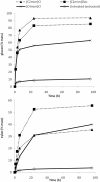Sugarcane bagasse pretreatment using three imidazolium-based ionic liquids; mass balances and enzyme kinetics
- PMID: 22920045
- PMCID: PMC3495841
- DOI: 10.1186/1754-6834-5-62
Sugarcane bagasse pretreatment using three imidazolium-based ionic liquids; mass balances and enzyme kinetics
Abstract
Background: Effective pretreatment is key to achieving high enzymatic saccharification efficiency in processing lignocellulosic biomass to fermentable sugars, biofuels and value-added products. Ionic liquids (ILs), still relatively new class of solvents, are attractive for biomass pretreatment because some demonstrate the rare ability to dissolve all components of lignocellulosic biomass including highly ordered (crystalline) cellulose. In the present study, three ILs, 1-butyl-3-methylimidazolium chloride ([C4mim]Cl), 1-ethyl-3-methylimidazolium chloride ([C2mim]Cl), 1-ethyl-3-methylimidazolium acetate ([C2mim]OAc) are used to dissolve/pretreat and fractionate sugarcane bagasse. In these IL-based pretreatments the biomass is completely or partially dissolved in ILs at temperatures greater than 130°C and then precipitated by the addition of an antisolvent to the IL biomass mixture. For the first time mass balances of IL-based pretreatments are reported. Such mass balances, along with kinetics data, can be used in process modelling and design.
Results: Lignin removals of 10% mass of lignin in bagasse with [C4mim]Cl, 50% mass with [C2mim]Cl and 60% mass with [C2mim]OAc, are achieved by limiting the amount of water added as antisolvent to 0.5 water:IL mass ratio thus minimising lignin precipitation. Enzyme saccharification (24 h, 15FPU) yields (% cellulose mass in starting bagasse) from the recovered solids rank as: [C2mim]OAc(83%) > >[C2mim]Cl(53%) = [C4mim]Cl(53%). Composition of [C2mim]OAc-treated solids such as low lignin, low acetyl group content and preservation of arabinosyl groups are characteristic of aqueous alkali pretreatments while those of chloride IL-treated solids resemble aqueous acid pretreatments. All ILs are fully recovered after use (100% mass as determined by ion chromatography).
Conclusions: In all three ILs regulated addition of water as an antisolvent effected a polysaccharide enriched precipitate since some of the lignin remained dissolved in the aqueous IL solution. Of the three IL studied [C2mim]OAc gave the best saccharification yield, material recovery and delignification. The effects of [C2mim]OAc pretreatment resemble those of aqueous alkali pretreatments while those of [C2mim]Cl and [C4mim]Cl resemble aqueous acid pretreatments. The use of imidazolium IL solvents with shorter alkyl chains results in accelerated dissolution, pretreatment and degradation.
Figures




Similar articles
-
Bacillus coagulans tolerance to 1-ethyl-3-methylimidazolium-based ionic liquids in aqueous and solid-state thermophilic culture.Biotechnol Prog. 2014 Mar-Apr;30(2):311-6. doi: 10.1002/btpr.1859. Epub 2014 Jan 11. Biotechnol Prog. 2014. PMID: 24376258
-
Schizosaccharomyces pombe as an Efficient Yeast to Convert Sugarcane Bagasse Pretreated with Ionic Liquids in Ethanol.Appl Biochem Biotechnol. 2018 Dec;186(4):960-971. doi: 10.1007/s12010-018-2788-1. Epub 2018 May 25. Appl Biochem Biotechnol. 2018. PMID: 29797299
-
Ternary ionic liquid-water pretreatment systems of an agave bagasse and municipal solid waste blend.Biotechnol Biofuels. 2017 Mar 21;10:72. doi: 10.1186/s13068-017-0758-4. eCollection 2017. Biotechnol Biofuels. 2017. PMID: 28344647 Free PMC article.
-
Transforming lignocellulosic biomass into biofuels enabled by ionic liquid pretreatment.Bioresour Technol. 2021 Feb;322:124522. doi: 10.1016/j.biortech.2020.124522. Epub 2020 Dec 10. Bioresour Technol. 2021. PMID: 33340950 Review.
-
Ionic Liquid Pretreatment of Lignocellulosic Biomass for Enhanced Enzymatic Delignification.Adv Biochem Eng Biotechnol. 2019;168:61-77. doi: 10.1007/10_2018_64. Adv Biochem Eng Biotechnol. 2019. PMID: 29744542 Review.
Cited by
-
Localization of polyhydroxybutyrate in sugarcane using Fourier-transform infrared microspectroscopy and multivariate imaging.Biotechnol Biofuels. 2015 Jul 10;8:98. doi: 10.1186/s13068-015-0279-y. eCollection 2015. Biotechnol Biofuels. 2015. PMID: 26199643 Free PMC article.
-
Moderate alkali-thermophilic ethanologenesis by locally isolated Bacillus licheniformis from Pakistan employing sugarcane bagasse: a comparative aspect of aseptic and non-aseptic fermentations.Biotechnol Biofuels. 2017 Apr 24;10:105. doi: 10.1186/s13068-017-0785-1. eCollection 2017. Biotechnol Biofuels. 2017. PMID: 28450886 Free PMC article.
-
Effect of Glycerol Concentrations on the Characteristics of Cellulose Films from Cattail (Typha angustifolia L.) Flowers.Polymers (Basel). 2023 Nov 25;15(23):4535. doi: 10.3390/polym15234535. Polymers (Basel). 2023. PMID: 38231905 Free PMC article.
-
The combination of plant-expressed cellobiohydrolase and low dosages of cellulases for the hydrolysis of sugar cane bagasse.Biotechnol Biofuels. 2014 Sep 9;7(1):131. doi: 10.1186/s13068-014-0131-9. eCollection 2014. Biotechnol Biofuels. 2014. PMID: 25254073 Free PMC article.
-
Imidazolium Based Ionic Liquids: A Promising Green Solvent for Water Hyacinth Biomass Deconstruction.Front Chem. 2018 Nov 21;6:548. doi: 10.3389/fchem.2018.00548. eCollection 2018. Front Chem. 2018. PMID: 30519555 Free PMC article.
References
-
- EIA (U.S. Energy Information Association) International Energy Outlook. 2010. http://www.eia.gov/forecasts/archive/ieo10/index.html.
-
- Kumar P, Barrett DM, Delwiche MJ, Stroeve P. Methods for pretreatment of lignocellulosic biomass for efficient hydrolysis and biofuel production. Ind Eng Chem Res. 2009;48(8):3713–3729.
-
- Mosier N, Wyman C, Dale B, Elander R, Lee YY, Holtzapple M, Ladisch M. Features of promising technologies for pretreatment of lignocellulosic biomass. Bioresour Technol. 2005;96(6):673–686. - PubMed
-
- Wyman CE, Dale BE, Elander RT, Holtzapple M, Ladisch MR, Lee YY. Coordinated development of leading biomass pretreatment technologies. Bioresour Technol. 2005;96(18):1959–1966. - PubMed
-
- Hamilton JK. The behaviour of wood carbohydrates in technical pulping processes. Pure Appl Chem. 1962;5(1–2):197–218.
LinkOut - more resources
Full Text Sources
Other Literature Sources

